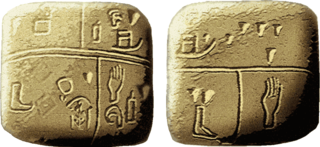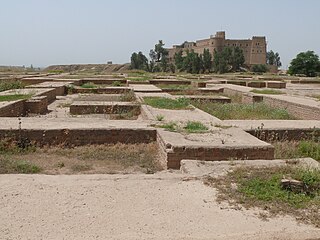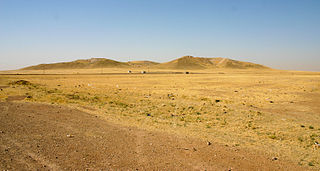 W
WThe Uruk period existed from the protohistoric Chalcolithic to Early Bronze Age period in the history of Mesopotamia, after the Ubaid period and before the Jemdet Nasr period. Named after the Sumerian city of Uruk, this period saw the emergence of urban life in Mesopotamia and the Sumerian civilization. The late Uruk period saw the gradual emergence of the cuneiform script and corresponds to the Early Bronze Age; it has also been described as the "Protoliterate period".
 W
WThe low tells at Abu Salabikh, around 20 km (12 mi) northwest of the site of ancient Nippur in Al-Qādisiyyah Governorate, Iraq mark the site of a small Sumerian city state of the mid third millennium BCE, with cultural connections to the cities of Kish, Mari and Ebla. Its contemporary name is uncertain: perhaps this was Eresh. Kesh was suggested by Thorkild Jacobsen before excavations began. The Euphrates was the city's highway and lifeline; when it shifted its old bed, in the middle third millennium BCE, the city dwindled away. Only eroded traces remain on the site's surface of habitation after the Early Dynastic Period. The site consists of several mounds, the 12 hectare wall enclosed Main, the 10 hectare Uruk, the West, and the 8 hectare South.
 W
WBeveled rim bowls are small, undecorated, mass-produced clay bowls most common in the 4th millennium B.C. They constitute roughly three quarters of all ceramics found in Uruk culture sites, are therefore a unique and reliable indicator of the presence of the Uruk culture in ancient Mesopotamia.
 W
WTappeh-ye Choghā Mīsh dating back to 6800 BC, is the site of a Chalcolithic settlement in Western Iran, located in the Khuzistan Province on the Susiana Plain. It was occupied at the beginning of 6800 BC and continuously from the Neolithic up to the Proto-Literate period, thus spanning the time periods from Archaic through Elamite. Later, the nearby Susa became culturally dominant in this area.
 W
WThe Erbil Citadel, locally called Qelat is a tell or occupied mound, and the historical city centre of Erbil in the Kurdistan Region of Iraq. The citadel has been inscribed on the World Heritage List since 21 June 2014.
 W
WEgypt–Mesopotamia relations were the relations between the civilisations of ancient Egypt and Mesopotamia, in the Middle East. They seem to have developed from the 4th millennium BCE, starting in the Uruk period for Mesopotamia and the half a millennium younger Gerzean culture of Prehistoric Egypt.
 W
WThe Gebel el-Arak Knife, also Jebel el-Arak Knife, is an ivory and flint knife dating from the Naqada II period of Egyptian prehistory, showing Mesopotamian influence. The knife was purchased in 1914 in Cairo by Georges Aaron Bénédite for the Louvre, where it is now on display in the Sully wing, room 20. At the time of its purchase, the knife handle was alleged by the seller to have been found at the site of Gebel el-Arak, but it is today believed to come from Abydos.
 W
WGodin Tepe is an archaeological site in western Iran, situated in the valley of Kangavar in Kermanshah Province. Discovered in 1961, the site was excavated from 1965 to 1973 by a Canadian expedition headed by T. Cuyler Young Jr. and sponsored by the Royal Ontario Museum. The importance of the site may have been due to its role as a trading outpost in the early Mesopotamian trade networks.
 W
WHabuba Kabira is the site of an Uruk settlement along the Euphrates in Syria, founded during the later part of the Uruk period. It was about 800 mi from the city of Uruk. The site is now mostly underwater due to the Tabqa Dam project.
 W
WHamoukar is a large archaeological site located in the Jazira region of northeastern Syria, near the Iraqi and Turkish borders. The early settlement dates back to the 5th millennium BCE, and it existed simultaneously with the Ubaid and the early Uruk cultures. It was a big centre of obsidian production. In the 3rd millennium, this was one of the largest cities of Northern Mesopotamia, and extended to 105 ha.
 W
WInanna is an ancient Mesopotamian goddess associated with love, beauty, sex, war, justice and political power. She was originally worshiped in Sumer under the name "Inanna", and was later worshipped by the Akkadians, Babylonians, and Assyrians under the name Ishtar. She was known as the "Queen of Heaven" and was the patron goddess of the Eanna temple at the city of Uruk, which was her main cult center. She was associated with the planet Venus and her most prominent symbols included the lion and the eight-pointed star. Her husband was the god Dumuzid and her sukkal, or personal attendant, was the goddess Ninshubur.
 W
WKhafajah or Khafaje is an archaeological site in Diyala Province (Iraq). It was part of the city-state of Eshnunna. The site lies 7 miles (11 km) east of Baghdad and 12 miles (19 km) southwest of Eshnunna.
 W
WThe Kish tablet is a limestone tablet found at the site of the ancient Sumerian city of Kish in modern-day Tell al-Uhaymir, Babil Governorate, Iraq. A plaster-cast of the artifact is today in the collection of the Ashmolean Museum.
 W
WMelid also known as Arslantepe was an ancient city on the Tohma River, a tributary of the upper Euphrates rising in the Taurus Mountains. It has been identified with the modern archaeological site of Arslantepe near Malatya, Turkey.
 W
WThe Piora Oscillation was an abrupt cold and wet period in the climate history of the Holocene Epoch; it is roughly dated to c. 3900-3000 BC. Some researchers associate the Piora Oscillation with the end of the Atlantic climate regime, and the start of the Sub-Boreal, in the Blytt–Sernander sequence of Holocene climates.
 W
WSusa is an ancient city in the lower Zagros Mountains about 250 km (160 mi) east of the Tigris, between the Karkheh and Dez Rivers in Iran. One of the most important cities of the Ancient Near East, Susa served as the capital of Elam and the Achaemenid Empire, and remained a strategic centre during the Parthian and Sasanian periods.
 W
WTell Brak was an ancient city in Syria; its remains constitute a tell located in the Upper Khabur region, near the modern village of Tell Brak, 50 kilometers north-east of Al-Hasaka city, Al-Hasakah Governorate. The city's original name is unknown. During the second half of the third millennium BC, the city was known as Nagar and later on, Nawar.
 W
WTell Uqair is a tell or settlement mound northeast of Babylon and about 50 miles (80 km) south of Baghdad in modern Babil Governorate, Iraq.
 W
WTepe Gawra is an ancient Mesopotamian settlement in the Mosul region of northwest Iraq that was occupied between 5000 and 1500 BC. It contains remains from the Halaf period, the Ubaid period, and the Uruk period. Tepe Gawra contains material relating to the Halaf-Ubaid Transitional period c. 5,500–5,000 BC.